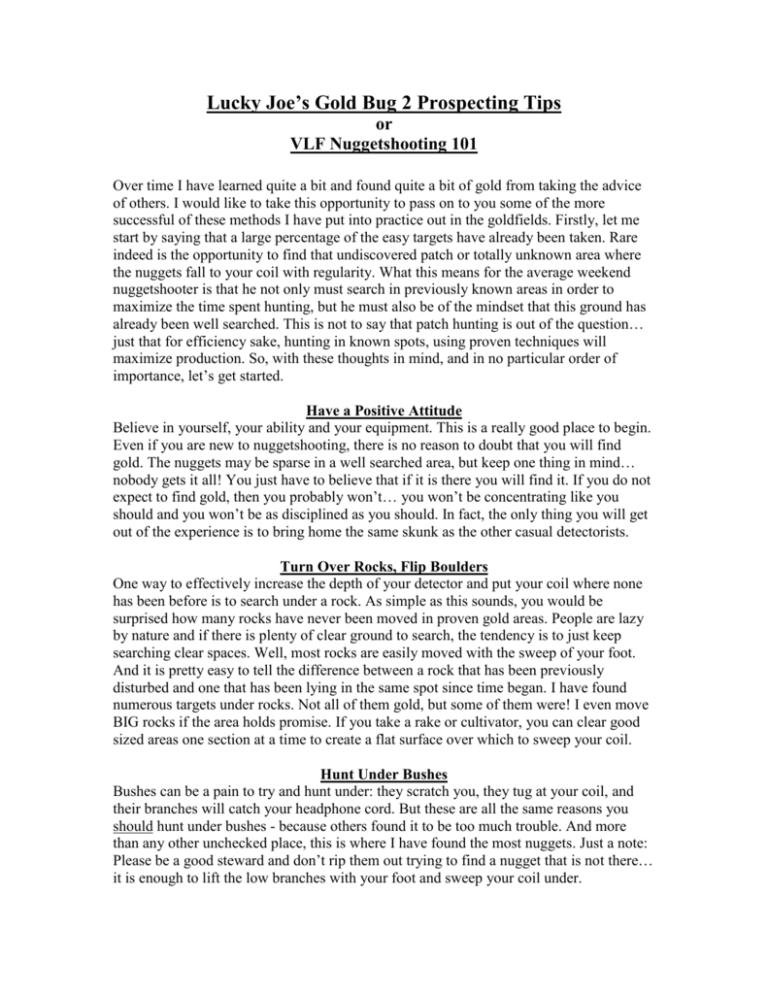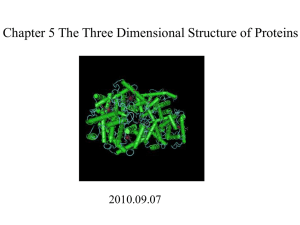Gold Bug 2 Gold Prospecting Tips
advertisement

Lucky Joe’s Gold Bug 2 Prospecting Tips or VLF Nuggetshooting 101 Over time I have learned quite a bit and found quite a bit of gold from taking the advice of others. I would like to take this opportunity to pass on to you some of the more successful of these methods I have put into practice out in the goldfields. Firstly, let me start by saying that a large percentage of the easy targets have already been taken. Rare indeed is the opportunity to find that undiscovered patch or totally unknown area where the nuggets fall to your coil with regularity. What this means for the average weekend nuggetshooter is that he not only must search in previously known areas in order to maximize the time spent hunting, but he must also be of the mindset that this ground has already been well searched. This is not to say that patch hunting is out of the question… just that for efficiency sake, hunting in known spots, using proven techniques will maximize production. So, with these thoughts in mind, and in no particular order of importance, let’s get started. Have a Positive Attitude Believe in yourself, your ability and your equipment. This is a really good place to begin. Even if you are new to nuggetshooting, there is no reason to doubt that you will find gold. The nuggets may be sparse in a well searched area, but keep one thing in mind… nobody gets it all! You just have to believe that if it is there you will find it. If you do not expect to find gold, then you probably won’t… you won’t be concentrating like you should and you won’t be as disciplined as you should. In fact, the only thing you will get out of the experience is to bring home the same skunk as the other casual detectorists. Turn Over Rocks, Flip Boulders One way to effectively increase the depth of your detector and put your coil where none has been before is to search under a rock. As simple as this sounds, you would be surprised how many rocks have never been moved in proven gold areas. People are lazy by nature and if there is plenty of clear ground to search, the tendency is to just keep searching clear spaces. Well, most rocks are easily moved with the sweep of your foot. And it is pretty easy to tell the difference between a rock that has been previously disturbed and one that has been lying in the same spot since time began. I have found numerous targets under rocks. Not all of them gold, but some of them were! I even move BIG rocks if the area holds promise. If you take a rake or cultivator, you can clear good sized areas one section at a time to create a flat surface over which to sweep your coil. Hunt Under Bushes Bushes can be a pain to try and hunt under: they scratch you, they tug at your coil, and their branches will catch your headphone cord. But these are all the same reasons you should hunt under bushes - because others found it to be too much trouble. And more than any other unchecked place, this is where I have found the most nuggets. Just a note: Please be a good steward and don’t rip them out trying to find a nugget that is not there… it is enough to lift the low branches with your foot and sweep your coil under. Use a Small Coil A small coil size (6” or less) will get you into tighter places than a big coil. The small coil can reach under bushes and right up against the base of a plant. It can get between rocks that are too heavy to move. And where bedrock is present above ground level, a small coil will allow you to work in between a lot of the pieces jutting up. These are all places where a bigger coil either can’t get to or has to be held higher off the ground. Either way, potential targets could have been left behind waiting for you to free them. Detect Hardrock Tailings Don’t ignore quartz tailing piles with your VLF (Very Low Frequency) detector. I actually heard about this from a nuggetshooter who originally used a BFO (Beat Frequency Oscillator) detector to detect quartz specimens. Pulse Inductor detectors cannot sense the gold in quartz unless it is present as a solid mass. VLFs do not suffer from this problem and instead sound off quite nicely on the smallest amount of gold veining in quartz. I quite recently put this advice into practice when I recognized an unmolested sorting pile left next to a prospector’s dig out in the Dale District. I proceeded to rake out the pile and detected four nice quartz specimen pieces from it. By the way, ‘sorting piles’ were explained to me by an old-timer by the name of Bob Dunkin who showed me what they looked like first hand. Basically, a sorting pile was the high-grade ore that an early miner set aside before he decided which of it to take to be crushed. The old-timers didn’t take it all, because usually space and weight were important considerations for them. So each piece was eyeballed for potential and discarded into a pile if it did not look worthwhile. One man’s trash is another man’s treasure! If You Hear a Repeatable Sound, Dig Sometimes (actually a lot of the time) all I hear is a slight variance in the threshold. These variances almost sound like ground noise or the types of noise you hear when you vary the height of the coil during a sweep. But have a little faith in your ability and assume that you did not change your sweep height. Perform a boot scrape to remove a little dirt and then recheck the signal: if it is not a metal target, the sound will remain the same or even degrade a bit. However, if it is a metal target, the sound should become more sharply defined. Recheck Your Dig Hole Nuggets often have a brother or sister hanging out with them, so sometimes there are multiple nuggets in one hole. It is the sorry prospector indeed who gets so excited over the first nugget to pop out that he forgets to recheck his hole – only to find out later from a fellow nuggethunter that another, bigger nugget was sitting below the first. (Some things are better not knowing.) Wear Headphones There is no way possible to hear the subtle variations in your threshold if you rely on the detector speaker… Wind noise, detector position, and any ambient sounds will cause you to miss hearing that quiet whisper that can lead to gold. Remember, in a well worked area all the screamers have already been dug. It is the mostly unnoticeable murmurs that are still waiting to be found. Go Slow This might not seem necessary because VLF detectors love to hit hard on metal even with a fast swing. However, most goldfields are full of hotrocks. And even though it is possible to differentiate between most hotrocks and a metal target, if the hotrock sound has not dissipated enough in your headphones, you will never hear the metal target that was right next to it. By slowing down your sweep, you give your ears and the detector circuits time to recover after blasting them over a hotrock. Faint targets will also become a bit more obvious with a slower sweep. Scrub the Ground as You Sweep I know, I know… this can be a source of falsing (the target-like sound a detector makes due to bumping the coil against an object). But if you want maximum depth you need to learn to do this effectively. If your coil cover isn’t getting worn out, you are not searching close enough to the ground. Search Fringe Areas Sometimes the heart of a patch has been so overworked that there is just nothing left to find. Whether this is the case or not, working to the outer boundaries and beyond of a patch can yield undiscovered targets or even extend the patch in a previously unknown direction. Dig Every Target and Investigate Every Repeatable Sound I cannot stress enough the importance of this. I have had plenty of gold nuggets sound like what was certain to be trash and also had plenty of threshold variances that turned into solid signals upon boot scraping. The misidentified sound is usually due to the shape and/or orientation of the nugget in the ground. If all targets are not dug, you will one day leave a nugget behind… This includes relying on a discriminator to tell you what is in the ground. Now, sometimes near the end of the day I am tired and almost hope that I do not get a signal. Once you do get to this point, turn the detector off and go rest: you will not be concentrating or swinging the detector like you should. And when that happens, you will either not investigate every sound or you will dismiss a target as trash without digging it. As you can see from most of the tips above, the main goal is to try and get your coil where none has been before. This gets harder with every passing year and especially so as interest in electronic prospecting grows. If you are lucky enough to have someone who knows their stuff and is willing to teach you, then take the time to learn from them. This will be time well spent, as your overall learning curve will be reduced far more than if you stumbled along by yourself. Experienced detectorists can teach you about your detector, the area you are hunting and many little nuances that will lead you to gold. All of the above mentioned techniques have netted me gold I would not have found otherwise. I hope they prove useful to you as well. Most importantly, have fun and be safe while enjoying this wonderful hobby. Take care. Lucky Joe





